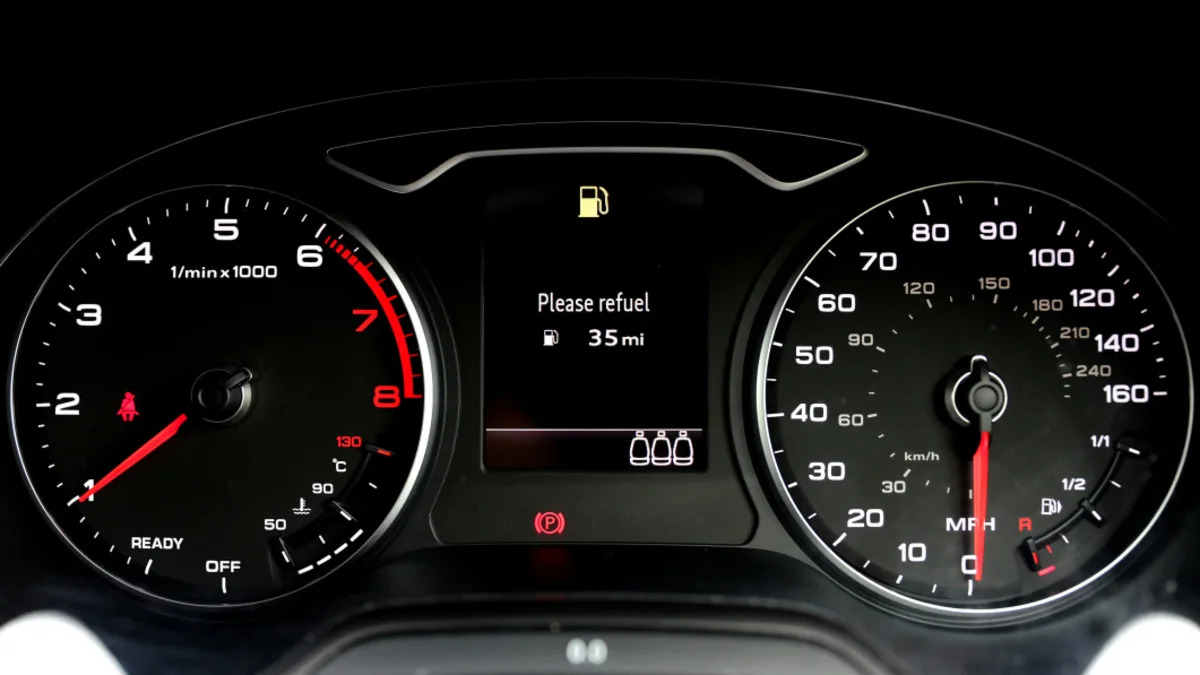In the United States, we measure fuel economy in terms of miles per gallon, or mpg. And the units are straight forward: it's a representation of how far you can drive in miles on a single gallon of fuel. The more miles you can go on a gallon, the more efficient the car is.
Fuel economy estimates, which are what you see on a car's window sticker, are covered with three separate numbers or figures.
What is city mpg versus highway and combined?
The three measurements you'll see on a car's window sticker or on sites like fueleconomy.gov are city fuel economy, highway fuel economy and a combined fuel economy figure. These are all calculated using a simulated driving loop from the EPA in each type of driving. City fuel economy is typically the lowest. This is because city driving is usually less efficient. Stops involve idling, in which fuel is being used but the car isn't going anywhere. And accelerating from a from stop uses more fuel than steady running.
Read more: Most fuel efficient vehicles of 2022
Highway numbers tend to be higher because it lacks those stops and acceleration. Instead, highway driving mainly features steady speeds at low rpm (how fast the engine is spinning), so not as much fuel is needed to travel long distances. The combined rating is based on a drive loop with both types of driving conditions, and thus usually falls between the other ratings.
When shopping, you'll want to consider what kind of driving your typical routine involves to get an idea of what your fuel economy may be.
What about mpg ratings for plug-in hybrids and electric cars?
Measuring efficiency in mpg is convenient for gasoline- and diesel-powered cars, since it's based on familiar distance units and the units used for how much fuel you have and will use. However, it gets complicated with plug-in hybrids and electric cars, since both can drive on electricity, which obviously isn't stored with a set volume of liquid.
Read more: All of our coverage on fuel efficiency
The EPA has tried to simplify comparisons with mpg-e, for miles per gallon of gasoline equivalence. It's based on how far a vehicle can drive on the equivalent amount of electrical energy as a gallon of gasoline. This can help in comparing how much more efficient an electric car is to a gas or diesel car, and even relative efficiency among EVs. But it can be a bit confusing, since electric cars store energy in units known as kilowatt-hours (kWh), not gallons of gasoline-equivalent. Additionally, most electric cars will display average consumption in miles per kWh on instruments, which is the most natural progression from mpg. The EPA does list consumption in kWh per mile on its website, though.
Is there a better efficiency measurement than miles per gallon?
This also brings us to a contentious aspect of measuring efficiency. Measuring in miles per gallon or kWh is arguably not the best way to express how thirsty or frugal a car is. It's handy for calculating how far you can go on a set amount of fuel, however, it obfuscates just how much fuel is being used to propel your vehicle. If the rating was gallons per mile or kWh per mile you would have a clear understanding of how much fuel or energy is being used for every mile driven. As explained in by Edmunds, this type of rating provides more accurate representation of efficiency gains or losses between cars and generations of cars, and it can be useful in understanding the amount of fuel used to go a distance and the cost of it. Even the EPA recognizes that mpg can skew efficiency differences, and explains the issue. In fact, Europe typically uses this type of unit for measuring fuel economy, though it's liters per kilometer because the continent uses the metric system.
Why do mpg ratings vary so much from country to country?
This brings us to our final topic, and that's test cycles. If you're keeping up with the latest car news, there are many cars that are released by companies overseas before they come to the U.S. They typically have fuel economy or electric range numbers given, but they're typically measured on the Worldwide Harmonized Light Vehicle Test Procedure. Just like with the EPA, it's a simulated test to get an idea of what kind of fuel economy a car will return in real life. But the test parameters are different from the EPA's, since it's based on different driving conditions and habits. Compared with EPA test numbers, WLTP numbers tend to be higher and not accurate for U.S. driving. So if you see numbers for a recently revealed car, keep an eye out for whether the numbers are from the WLTP test. If so, you can expect the numbers to be lower for the U.S.
What can you do to improve your fuel economy?
We're glad you asked! We've covered the topic of improving your fuel economy in another feature that you can read here. Here are a few tips that you'll read a lot more about in the article.
- Make sure your tires are properly inflated
- Maintain your car
- Avoid long warmups
- Look far down the road
- Don't carry unnecessary weight
- Keep a constant throttle position
- Avoid cold temperatures
- Avoid hot temperatures
There are a lot more useful tips in the full article. Even if you can't incorporate all of them, even some small changes in your routine could make a measurable difference.


Sign in to post
Please sign in to leave a comment.
Continue